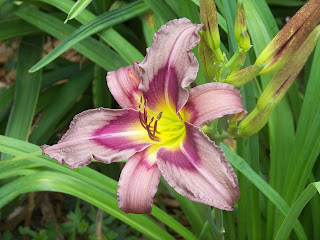
.JPG)
.JPG)
.JPG)
.JPG)
Images are all Hollyhock flowers. All but the yellow are from seeds given to me by others and I just call them "old". The yellow is "Alcea Rugosa".
Let me start by saying, "I've never seen a hollyhock flower I didn't want to photograph." I think it all started in my childhood. The farm yard had hollyhocks growing here and there and I often picked them for various projects.
One of my favorites (hand drawn image above) was to make "Hollyhock Ladies". (1) take a hollyhock flower in full bloom, (2) turn it upside down, (3) put a toothpick into the top, (4) push a partially opened flower bud all the way down the toothpick (the petals should be on top), (5) finish by pushing another toothpick cross ways at the top of the bottom flower. Is it obvious I was a farm child prior to TV, electronics, and boredom as an excuse?
Hollyhocks comprise about 60 species of flowering plants in the genus Alcea in the mallow family. Although, in the 1800s there were over 80 named species. It is native to southwest and central Asia. From 6 - 10 foot tall with broad, rounded, palmate lobed leaves.
Hollyhocks will have numerous flowers on an erect central stem. They start blooming from the lower buds first. Blooms are in shades of very light pink to very dark burgundy and shades of peach and yellow. Varieties include singles, doubles and semi-doubles. The old ones often cross pollinate which will produce new color combinations each year. They are a favorite for bees.
Most hollyhocks are biennial - meaning the first year it forms a low leafy mat and the second year it blooms. A few are short lived perennials. They self seed easily. While individual plants may only last a handful of years, chances are good it will leave plenty of decedents. They have a very long tap root which makes transplanting difficult but not impossible if they are kept watered until established. They will grow in Zones 3 to 10. They seldom need additional watering or fertilizer.
They are the host plant of Bucculatrix quadrigemina and the Painted Lady Vanessa cardui butterfly.
They are drought resistant and do well in full sun. They may have leaf spot and hollyhock rust caused by a fungi that overwinters in the soil. In late fall, remove all seeds (either scatter over areas or store for future planting or as gifts), pull up plants and destroy. Do not compost. You can use a Bordeaux mix or sulfur-based fungicide spray in the summer to help control these problems.
Often used in the English cottage gardens, the tall hollyhocks were also a way of hiding the outhouse.
Hollyhocks are thought to have been named for their origin in the Holy Land and for their supposedly divine curative power (the English called them "hock leaf" for they were used to treat the swollen hocks (ankles) on horses.)
"The earth laughs in flowers." Ralph Waldo Emerson






.JPG)



.JPG)
.JPG)
.JPG)


.JPG)

.JPG)





.JPG)
.JPG)
+-+Copy.JPG)


.JPG)

.JPG)


.JPG)


.JPG)

